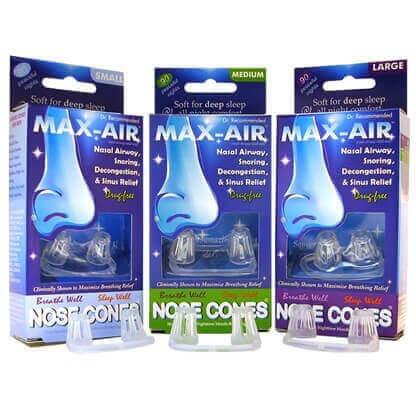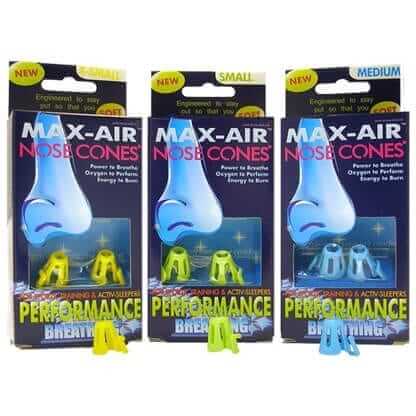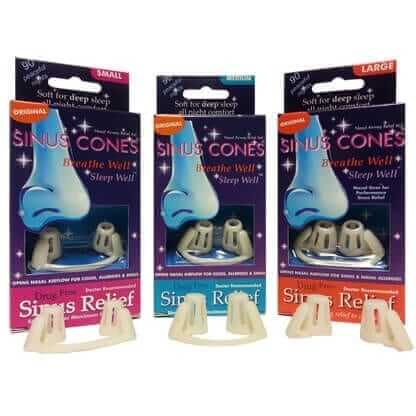CALL: 1-800-797-0361 (M-F 8AM-6PM EST)
Royal College of Surgeons in the UK conducted an independent clinical study to determine how well the Sinus Cones nasal dilators work to relieve nasal collapse.
The study results were so good that they were published in the Annals of Allergy, Asthma, and Immunology. The published article, “Removing nasal valve obstruction in peak nasal inspiratory flow measurement.” compares Sinus Cones to another nasal dilator. The researchers conclude that:
SINUS CONES, but not Nozovents, significantly improved peak nasal inspiratory flow (PNIF).
Martyn L. Barnes, MBBS, Asthma and Allergy Research Group, Royal College of Surgeons
What are the symptoms of nasal collapse?
The symptoms of nasal collapse can often be confused with other symptoms of nasal airway obstruction or nasal congestion because the feeling of nasal blockage or stuffiness is often the same.
There are three tests to determine if your symptoms are due to nasal collapse or another type of nasal airway obstruction.
The first two tests will show if you have “inspiratory nasal collapse”. Inspiratory nasal collapse means that the collapse only occurs when you inhale.
The third test will show if you have a structural problem and the sidewalls of the nose are always collapsed (or caved in). Some noses collapse more than others based on structure, previous damage to the nose and age.
How to test for nasal valve collapse.
1) Try to inhale through your nose as fast and as much as possible. If the more and faster you inhale, the less you can inhale, then you have nasal collapse.
2) Looking straight at yourself in the mirror, or take a video selfie with your phone, inhaling and exhale normally through your nose with your mouth closed. If the sidewalls of your nose suck in when you do this, then you have nasal collapse.
3) Take a photo up into the nasal airways. If the opening inside the nasal airway is collapsed into the opening, then you have what is called pathological nasal valve collapse.
How does nasal collapse happen?
Nasal collapse occurs when the skin of the sidewall of the nose isn’t resilient enough to sustain the vacuum-pressure caused by inhaling fully through the nose. The sidewall is literally “sucked” inward collapsing the nose and blocking nasal airflow.
What are the origins of nasal collapse?
Nasal collapse can be pathologic in nature, meaning that it is just due to the way the nose is formed, or it can be caused by trauma to the nose.
An example of nasal trauma is a broken nose. When the nose is broken, the nasal bone and/or nasal septum cartilage may shift off-center. The result is that the sidewall of the nose is no longer supported by the nasal septum, because once the septum is shifted, there is no support to hold the sidewall open. As a consequence it collapses inward upon inhalation and blocks the nasal airway.
Nasal collapse can also be due to a change in nasal anatomy from functional nasal surgery such as septoplasty, (surgery performed to straighten the nasal septum to relieve nasal obstruction and improve nasal airflow).
Or, nasal collapse may be due to cosmetic nasal surgery such as a rhinoplasty (cosmetic surgery to improve the shape of the nose).
Irrespective of the origins of nasal collapse, nasal collapse is often most problematic during sleep and upon inhaling forcefully especially during sports. As shown in the video, inhaling creates suction forcing the sidewall to collapse and block the airflow, which frequently results in a feeling of a blocked nose, nighttime airway stuffy nose, or chronic nasal congestion.
How do you relieve nasal valve collapse?
Some people try to relieve nasal collapse during sleep by training themselves to pull their cheek away from their nose to hold the nasal airway open during sleep. Others try to sleep sitting up so to prevent their noses from collapsing against the pillow. While, others try to train themselves to sleep just on one side, or only on their backs (which is not only uncomfortable but also a formula for snoring and sleep loss).
Try our simple solution to relieve nasal valve collapse.
Nasal collapse is easily relieved by our nasal dilators, Sinus Cones. They are soft yet firm enough to resist the collapse of the nasal sidewall when you inhale. If you want to breathe fully and sleep deeply, and stretch out and relax in any position that you want, give them a try. Our soft, internal nasal dilators Sinus Cones may offer just the relief that you seek to this common breathing and sleeping problem.
Removing nasal valve obstruction in peak nasal inspiratory flow measurement
Martyn L. Barnes, Brian J. Lipworth Annals of Allergy, Asthma & Immunology
July 2007 (Vol. 99, Issue 1, Pages 59-60)




